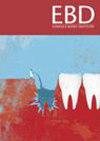在预防儿童早期龋齿方面,我们是否可以依靠推迟糖的摄入量?
Q3 Dentistry
引用次数: 0
摘要
Feldens C A, de Barros Coelho E M R, Vítolo M R, Rogrigues P H, Kramer P F, Peres K G:一项在巴西开展的多中心随机试验:生命第一年预防糖摄入规划对儿童早期龋齿发生的有效性。龋齿研究2024;https://doi.org/10.1159/000541028 .研究设计:在巴西进行了一项多中心随机对照试验。干预组根据儿童基金会制定的膳食准则接受营养咨询。对照组接受医院提供的标准饮食和产妇咨询。参与者的随机化是通过基于计算机的系统完成的,研究者对招募过程不知情。每月通过电话和家访对患者进行随访。样本:孕妇是从三个州首府的四家医院招募的,她们参加了“爱婴医院倡议”。母亲必须年满18岁,HIV/HTLV1检测呈阴性,并且没有并发症的怀孕。这些新生儿的胎龄必须超过37周,体重必须超过2.5公斤。由于感染或影响母乳喂养的新生儿状况而住院时间增加的新生儿未包括在内。进行样本量计算。数据分析:收集基线数据。每隔6个月和12个月,使用有效问卷的组合,包括24小时回忆和访谈来评估饮食。口腔健康评估由一名盲法、经过培训和校准的儿科牙医进行。主要结局是ECC减少。计算效果测量(相对风险[RR]),以确定干预对6个月时不吃糖和12个月时平均吃糖量的影响。结果:干预组和对照组的基线人口统计数据相似,无显著差异。干预组前6个月不吃糖的概率是对照组的2.4倍(p = 0.016)。17.4%的患者诊断为ECC;然而,各组间在任何时间点均无显著差异(p = 0.281)。结论:在母亲出生后的前6个月增加干预对减少糖的摄入量是有效的。然而,这并没有导致统计学上显著的ECC减少。本文章由计算机程序翻译,如有差异,请以英文原文为准。
Can we rely on delaying the uptake of sugar consumption in the prevention of early childhood caries?
Feldens C A, de Barros Coelho E M R, Vítolo M R, Rogrigues P H, Kramer P F, Peres K G Effectiveness of a sugar consumption prevention programme in the first year of life on the occurrence of early childhood caries: a multicentric randomized trial in Brazil. Caries Res 2024; https://doi.org/10.1159/000541028 . A multi-centre randomised controlled trial was carried out in Brazil. The intervention group received nutritional counselling based on dietary guidelines produced by UNICEF. The control group received standard dietary and maternal counselling provided by the hospital provider. Randomisation of participants was completed through a computer-based system with an investigator blinded to the recruitment process. Patients were followed up monthly using a combination of phone calls and home visits. Pregnant women were recruited from four hospitals, across three state capitals, participating in the Baby Friendly Hospital Initiative. Mothers were to be at least 18 years of age, testing negative for HIV/HTLV1, and had an uncomplicated pregnancy. Their newborns had to have a gestational age of more than 37 weeks and weigh more than 2.5 kg. A newborn with increased hospital stays due to infection or neonatal conditions which affected breastfeeding were not included. Sample size calculation was undertaken. Baseline data was collected. At 6- and 12-month intervals, a combination of validated questionnaires, including 24-hour recalls, and interviews were used to assess the diet. Oral health assessments were carried out by a blinded, trained and calibrated paediatric dentist. The primary outcome was a reduction in ECC. Effect measures (relative risk [RR]) were calculated to determine the effect of the intervention on not consuming sugar at 6 months and on the mean number of sugary items consumed at 12 months. Baseline demographic data were similar, with no significant differences noted, between the intervention and control groups. The probability of not consuming sugar in the first 6-months was 2.4 times less in the intervention group relative to the control group (p = 0.016). ECC was diagnosed in 17.4% of the whole sample; however, no significant difference was noted between groups at any time point (p = 0.281). Increased intervention to the mother in the first 6-months of life was effective at reducing the amount of sugar intake. However, this did not lead to a statistically significant reduction in ECC.
求助全文
通过发布文献求助,成功后即可免费获取论文全文。
去求助
来源期刊

Evidence-based dentistry
Dentistry-Dentistry (all)
CiteScore
2.50
自引率
0.00%
发文量
77
期刊介绍:
Evidence-Based Dentistry delivers the best available evidence on the latest developments in oral health. We evaluate the evidence and provide guidance concerning the value of the author''s conclusions. We keep dentistry up to date with new approaches, exploring a wide range of the latest developments through an accessible expert commentary. Original papers and relevant publications are condensed into digestible summaries, drawing attention to the current methods and findings. We are a central resource for the most cutting edge and relevant issues concerning the evidence-based approach in dentistry today. Evidence-Based Dentistry is published by Springer Nature on behalf of the British Dental Association.
 求助内容:
求助内容: 应助结果提醒方式:
应助结果提醒方式:


